Abstract
The suprachiasmatic nucleus (SCN) of the hypothalamus is thought to play a critical role in circadian rhythm generation and entrainment to the light/dark cycle. In adult rats, the SCN shows a circadian rhythm in metabolic activity level as indicated by 2-deoxy[1-14C]glucose uptake. In the present study, the development of this rhythm was investigated. No diurnal difference in uptake was evident in fetal rats 1--2 days before birth. A significant diurnal difference in SCN 2-deoxyglucose uptake was preseno light at night increased the SCN metabolic levels. According to previous studies, on day 1 the SCN is poorly developed and contains few synapses. At this time the retinohypothalamic tract has not yet developed. We found progressive functional maturation of the SCN through day 21, when the rhythm and light responsiveness resembled those of adult rats.
Full text
PDF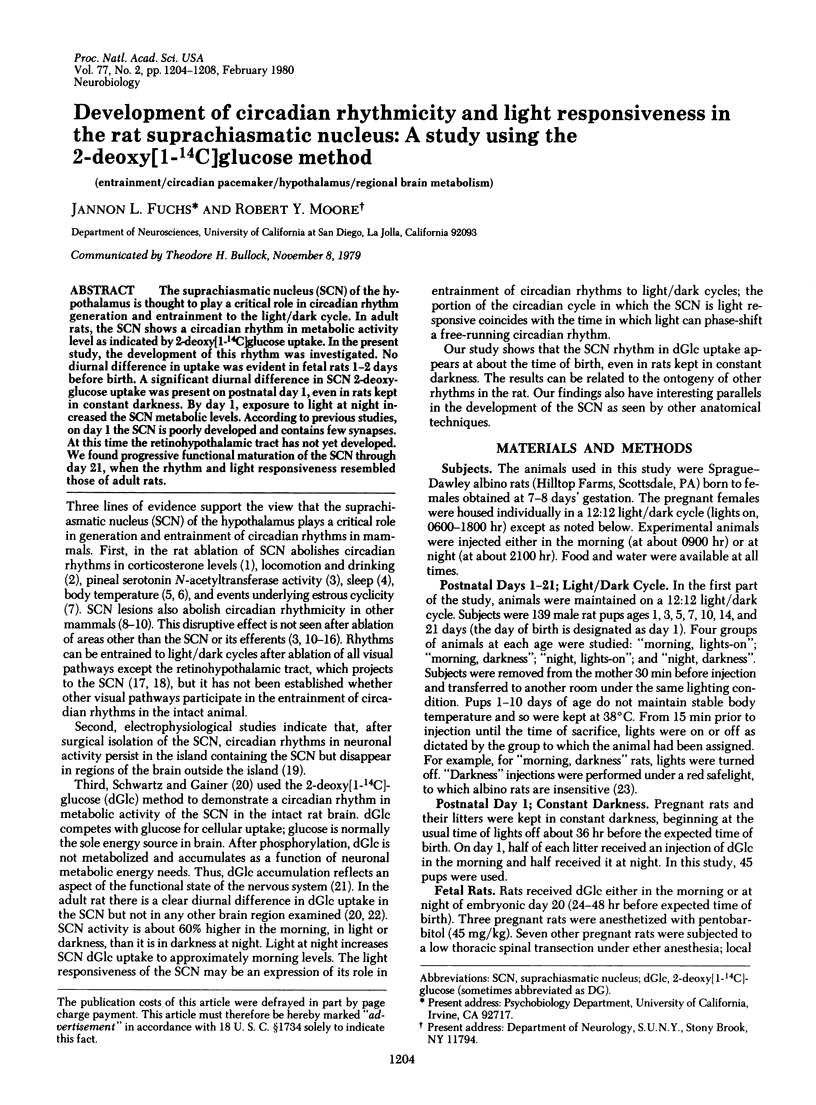
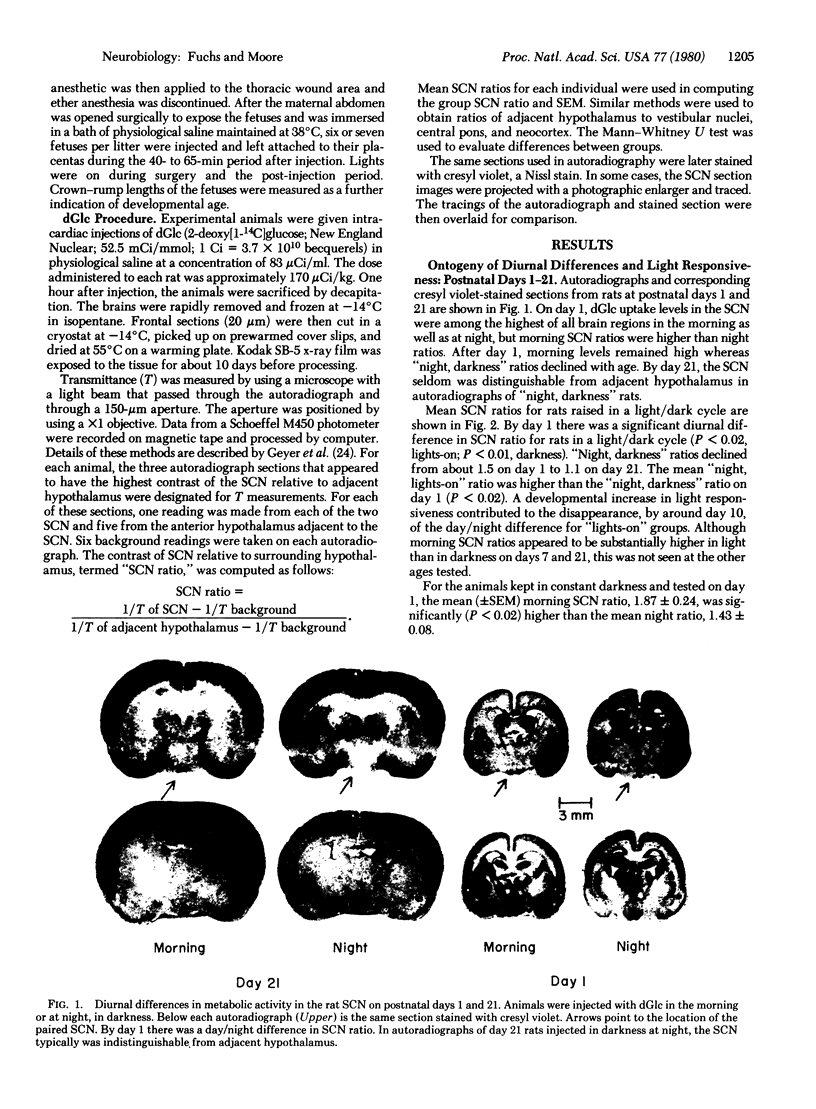
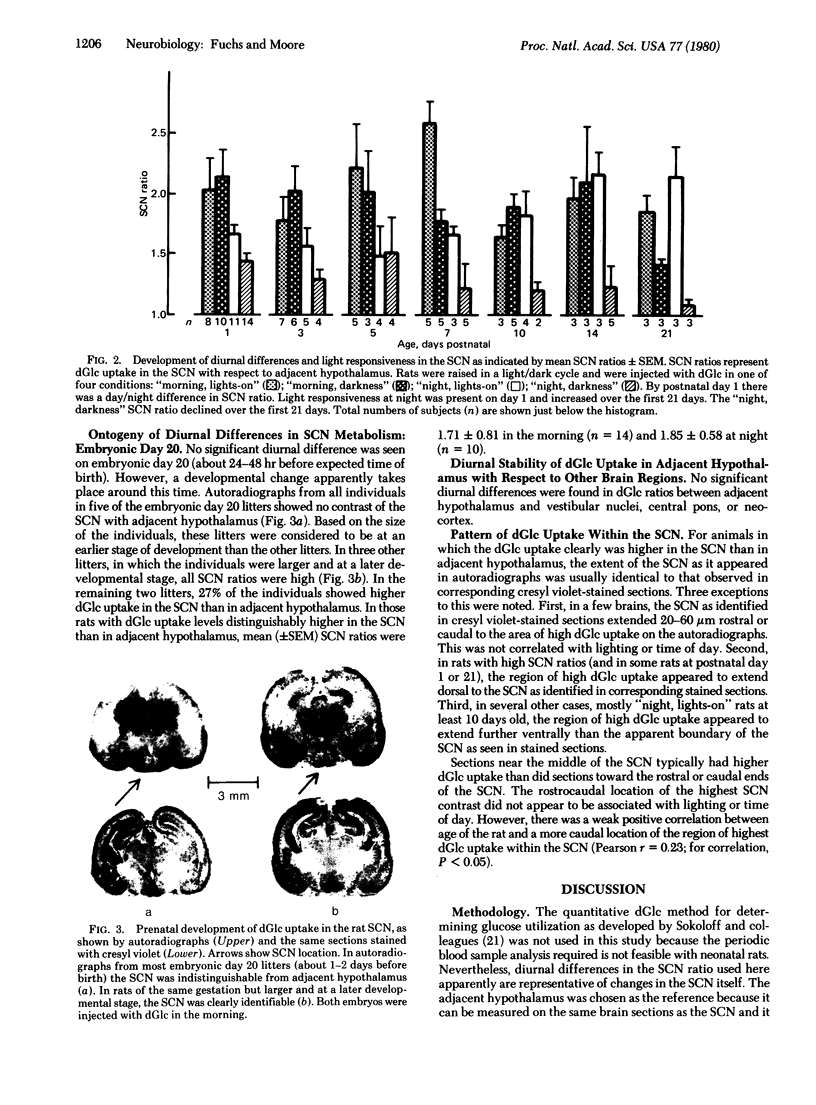
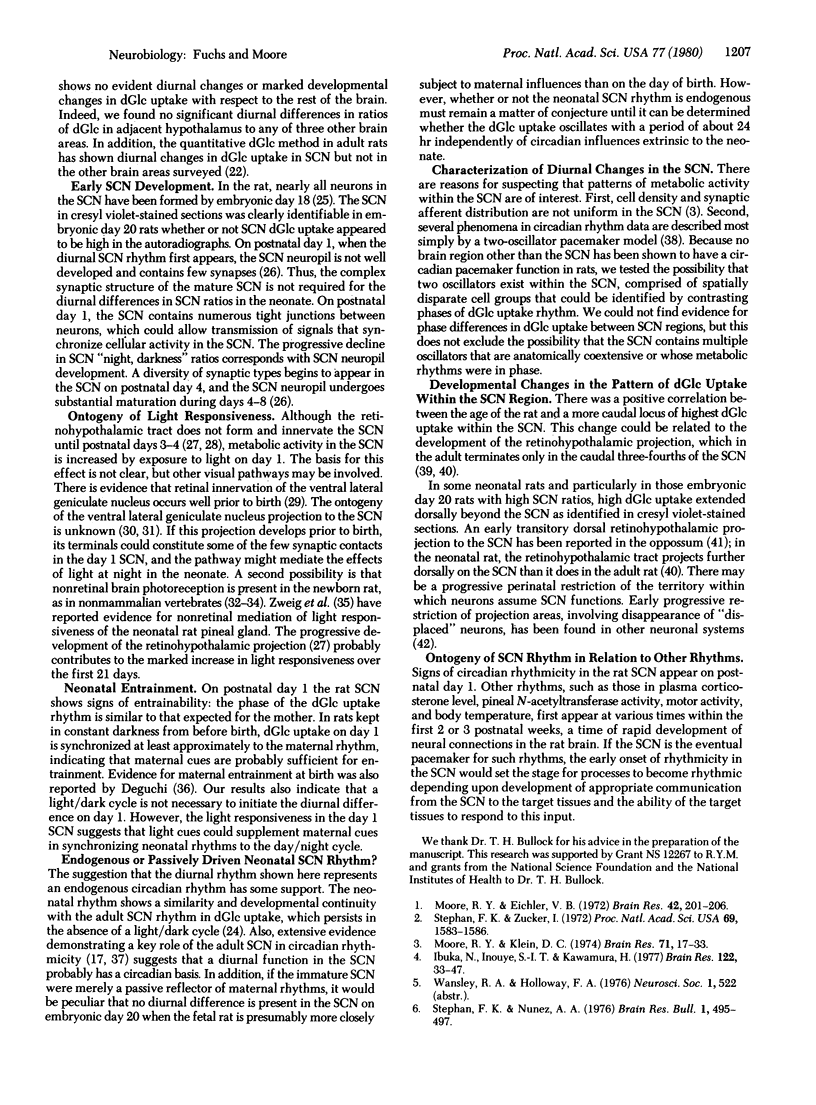
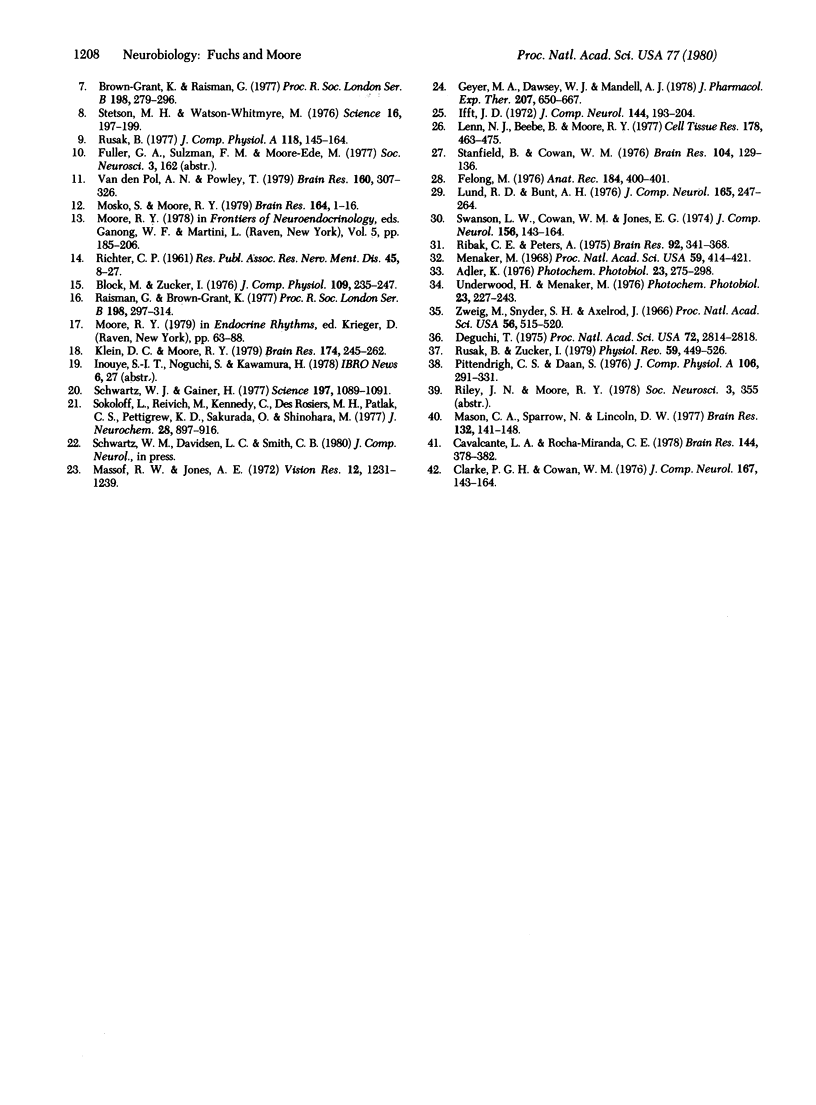
Images in this article
Selected References
These references are in PubMed. This may not be the complete list of references from this article.
- Adler K. Extraocular photoreception in amphibians. Photophysiology. 1976 Apr;23(4):275–298. [PubMed] [Google Scholar]
- Brown-Grant K., Raisman G. Abnormalities in reproductive function associated with the destruction of the suprachiasmatic nuclei in female rats. Proc R Soc Lond B Biol Sci. 1977 Sep 5;198(1132):279–296. doi: 10.1098/rspb.1977.0098. [DOI] [PubMed] [Google Scholar]
- Cavalcante L. A., Rocha-Miranda C. E. Development of retinohypothalamic and accessory optic projections in the opossum. Brain Res. 1978 Apr 14;144(2):378–382. doi: 10.1016/0006-8993(78)90164-6. [DOI] [PubMed] [Google Scholar]
- Clarke P. G., Cowan W. M. The development of the isthmo-optic tract in the chick, with special reference to the occurrence and correction of developmental errors in the location and connections of isthmo-optic neurons. J Comp Neurol. 1976 May 15;167(2):143–164. doi: 10.1002/cne.901670203. [DOI] [PubMed] [Google Scholar]
- Deguchi T. Ontogenesis of a biological clock for serotonin:acetyl coenzyme A N-acetyltransferase in pineal gland of rat. Proc Natl Acad Sci U S A. 1975 Jul;72(7):2814–2818. doi: 10.1073/pnas.72.7.2814. [DOI] [PMC free article] [PubMed] [Google Scholar]
- Geyer M. A., Dawsey W. J., Mandell A. J. Fading: a new cytofluorimetric measure quantifying serotonin in the presence of catecholamines at the cellular level in brain. J Pharmacol Exp Ther. 1978 Nov;207(2):650–667. [PubMed] [Google Scholar]
- Ibuka N., Inouye S. I., Kawamura H. Analysis of sleep-wakefulness rhythms in male rats after suprachiasmatic nucleus lesions and ocular enucleation. Brain Res. 1977 Feb 11;122(1):33–47. doi: 10.1016/0006-8993(77)90660-6. [DOI] [PubMed] [Google Scholar]
- Ifft J. D. An autoradiographic study of the time of final division of neurons in rat hypothalamic nuclei. J Comp Neurol. 1972 Feb;144(2):193–204. doi: 10.1002/cne.901440204. [DOI] [PubMed] [Google Scholar]
- Klein D. C., Moore R. Y. Pineal N-acetyltransferase and hydroxyindole-O-methyltransferase: control by the retinohypothalamic tract and the suprachiasmatic nucleus. Brain Res. 1979 Oct 5;174(2):245–262. doi: 10.1016/0006-8993(79)90848-5. [DOI] [PubMed] [Google Scholar]
- Lenn N. J., Beebe B., Moore R. Y. Postnatal development of the suprachiasmatic hypothalamic nucleus of the rat. Cell Tissue Res. 1977 Mar 24;178(4):463–475. doi: 10.1007/BF00219568. [DOI] [PubMed] [Google Scholar]
- Lund R. D., Bunt A. H. Prenatal development of central optic pathways in albino rats. J Comp Neurol. 1976 Jan 15;165(2):247–264. doi: 10.1002/cne.901650209. [DOI] [PubMed] [Google Scholar]
- Mason C. A., Sparrow N., Lincoln D. W. Structural features of the retinohypothalamic projection in the rat during normal development. Brain Res. 1977 Aug 19;132(1):141–148. doi: 10.1016/0006-8993(77)90711-9. [DOI] [PubMed] [Google Scholar]
- Massof R. W., Jones A. E. Electroretinographic evidence for a photopic system in the rat. Vision Res. 1972 Jul;12(7):1231–1239. doi: 10.1016/0042-6989(72)90194-0. [DOI] [PubMed] [Google Scholar]
- Menaker M. Extraretinal light perception in the sparrow. I. Entrainment of the biological clock. Proc Natl Acad Sci U S A. 1968 Feb;59(2):414–421. doi: 10.1073/pnas.59.2.414. [DOI] [PMC free article] [PubMed] [Google Scholar]
- Moore R. Y., Eichler V. B. Loss of a circadian adrenal corticosterone rhythm following suprachiasmatic lesions in the rat. Brain Res. 1972 Jul 13;42(1):201–206. doi: 10.1016/0006-8993(72)90054-6. [DOI] [PubMed] [Google Scholar]
- Moore R. Y., Klein D. C. Visual pathways and the central neural control of a circadian rhythm in pineal serotonin N-acetyltransferase activity. Brain Res. 1974 May 10;71(1):17–33. doi: 10.1016/0006-8993(74)90188-7. [DOI] [PubMed] [Google Scholar]
- Mosko S., Moore R. Y. Retinohypothalamic tract development: alteration by suprachiasmatic lesions in the neonatal rat. Brain Res. 1979 Mar 23;164:1–15. doi: 10.1016/0006-8993(79)90002-7. [DOI] [PubMed] [Google Scholar]
- Raisman G., Brown-Grant K. The 'suprachiasmatic syndrome': endocrine and behavioural abnormalities following lesions of the suprachiasmatic nuclei in the female rat. Proc R Soc Lond B Biol Sci. 1977 Sep 5;198(1132):297–314. doi: 10.1098/rspb.1977.0099. [DOI] [PubMed] [Google Scholar]
- Ribak C. E., Peters A. An autoradiographic study of the projections from the lateral geniculate body of the rat. Brain Res. 1975 Jul 18;92(3):341–368. doi: 10.1016/0006-8993(75)90322-4. [DOI] [PubMed] [Google Scholar]
- Richter C. P. Sleep and activity: their relation to the 24-hour clock. Res Publ Assoc Res Nerv Ment Dis. 1967;45:8–29. [PubMed] [Google Scholar]
- Rusak B., Zucker I. Neural regulation of circadian rhythms. Physiol Rev. 1979 Jul;59(3):449–526. doi: 10.1152/physrev.1979.59.3.449. [DOI] [PubMed] [Google Scholar]
- Schwartz W. J., Gainer H. Suprachiasmatic nucleus: use of 14C-labeled deoxyglucose uptake as a functional marker. Science. 1977 Sep 9;197(4308):1089–1091. doi: 10.1126/science.887940. [DOI] [PubMed] [Google Scholar]
- Sokoloff L., Reivich M., Kennedy C., Des Rosiers M. H., Patlak C. S., Pettigrew K. D., Sakurada O., Shinohara M. The [14C]deoxyglucose method for the measurement of local cerebral glucose utilization: theory, procedure, and normal values in the conscious and anesthetized albino rat. J Neurochem. 1977 May;28(5):897–916. doi: 10.1111/j.1471-4159.1977.tb10649.x. [DOI] [PubMed] [Google Scholar]
- Stanfield B., Cowan W. M. Evidence for a change in the retino-hypothalamic projection in the rat following early removal of one eye. Brain Res. 1976 Mar 5;104(1):129–136. doi: 10.1016/0006-8993(76)90652-1. [DOI] [PubMed] [Google Scholar]
- Stephan F. K., Zucker I. Circadian rhythms in drinking behavior and locomotor activity of rats are eliminated by hypothalamic lesions. Proc Natl Acad Sci U S A. 1972 Jun;69(6):1583–1586. doi: 10.1073/pnas.69.6.1583. [DOI] [PMC free article] [PubMed] [Google Scholar]
- Stephan F., Nunez A. A. Role of retino-hypothalamic pathways in the entrainment of drinking rhythms. Brain Res Bull. 1976 Sep-Oct;1(5):495–497. [PubMed] [Google Scholar]
- Stetson M. H., Watson-Whitmyre M. Nucleus suprachiasmaticus: the biological clock in the hamster? Science. 1976 Jan 16;191(4223):197–199. doi: 10.1126/science.942799. [DOI] [PubMed] [Google Scholar]
- Swanson L. W., Cowan W. M., Jones E. G. An autoradiographic study of the efferent connections of the ventral lateral geniculate nucleus in the albino rat and the cat. J Comp Neurol. 1974 Jul;156(2):143–163. doi: 10.1002/cne.901560203. [DOI] [PubMed] [Google Scholar]
- Underwood H., Menaker M. Extraretinal photoreception in lizards. Photophysiology. 1976 Apr;23(4):227–243. [PubMed] [Google Scholar]
- Van den Pol A. N., Powley T. A fine-grained anatomical analysis of the role of the rat suprachiasmatic nucleus in circadian rhythms of feeding and drinking. Brain Res. 1979 Jan 12;160(2):307–326. doi: 10.1016/0006-8993(79)90427-x. [DOI] [PubMed] [Google Scholar]
- Zweig M., Snyder S. H., Axelrod J. Evidence for a nonretinal pathway of light to the pineal gland of newborn rats. Proc Natl Acad Sci U S A. 1966 Aug;56(2):515–520. doi: 10.1073/pnas.56.2.515. [DOI] [PMC free article] [PubMed] [Google Scholar]




